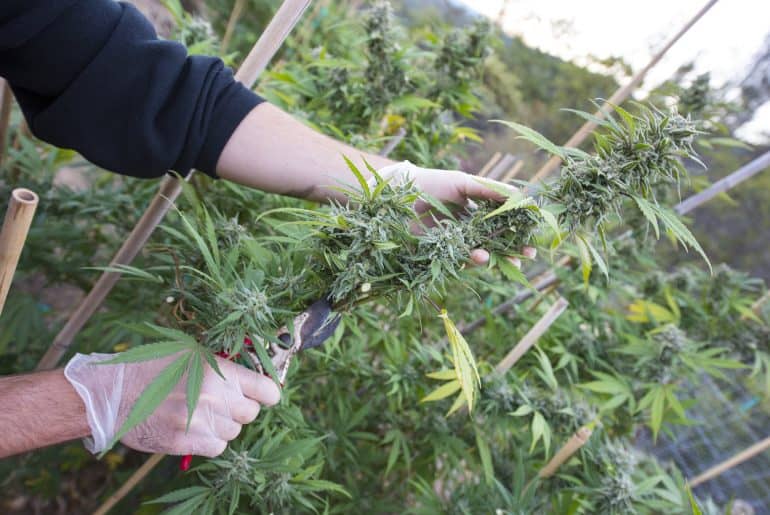Of course, one of your main goals when growing cannabis is to produce the maximum yield possible. There are some plants out there that can produce literally thousands of grams of marijuana, but in order to accomplish this, you need to follow a plethora of tips and rules.
Yes, providing your plants with the right amount of nutrients, light, water, and growing conditions is very important. However, what many people don’t realize is that trimming marijuana plants or pruning cannabis plants can also be very beneficial to help increase the overall yield or production rate.
The reason for this is very multifaceted, as pruning cannabis plants provides many different benefits to those plants, all of which may lead to a bigger yield at the end of the day. That being said, be aware that here we are not talking about trimming your marijuana plants down to size once you have already harvested them.
Here, we are talking about trimming or pruning your marijuana plants while they are still growing. Although it may seem counterintuitive to cut plant material away in order to increase yields, this is a proven method, and a lot of it has to do with sun exposure and light absorption.
By removing certain parts of the plant that are deemed useless or not are not providing any benefit, you can increase the overall productivity of your cannabis plant. Right now, we’re going to provide you with an in-depth guide on when and how to trim marijuana plants for a maximum yield.
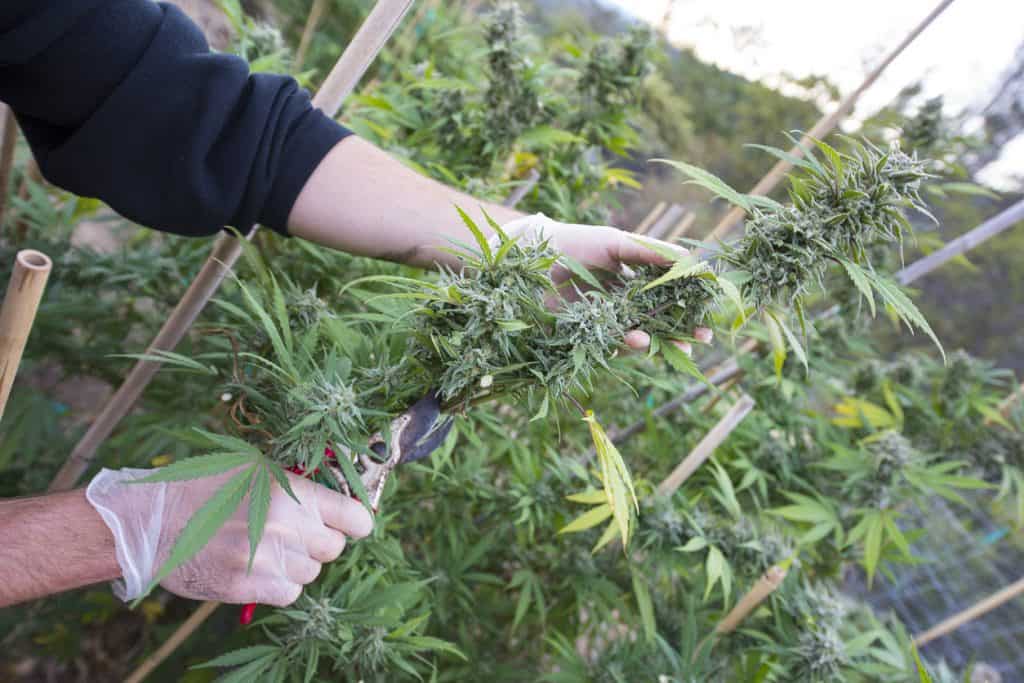
What is Trimming a Cannabis Plant?
Trimming a cannabis plant, otherwise known as pruning a cannabis plant is an important step that can help you increase the overall quality and yield. Trimming or pruning involves cutting away certain leaves or areas of the plant that are not serving any purpose.
Moreover, even if some areas are serving a purpose, the rest of the plant may benefit more by cutting those areas away. For instance, using a technique known as defoliation, which involves removing some of the bigger fan leaves during the flowering stage, may result in increased energy being focused on the growth of buds, as opposed to maintaining foliage.
This is just one example of how pruning a cannabis plant can be very beneficial. However, you can’t just start cutting away random parts of the plant. You need to cut away the right parts of the plant at the right times, or else you will do more harm than good, and this is essentially what we are here to teach you today.
The Importance of Pruning Marijuana Plants
There are a number of big benefits that you get when you prune or trim your marijuana plants, so let’s take a look at what these might be. As you are about to find out, there are some pretty key benefits to trimming marijuana plants, and they are all about spurring on healthy growth and thick branches.
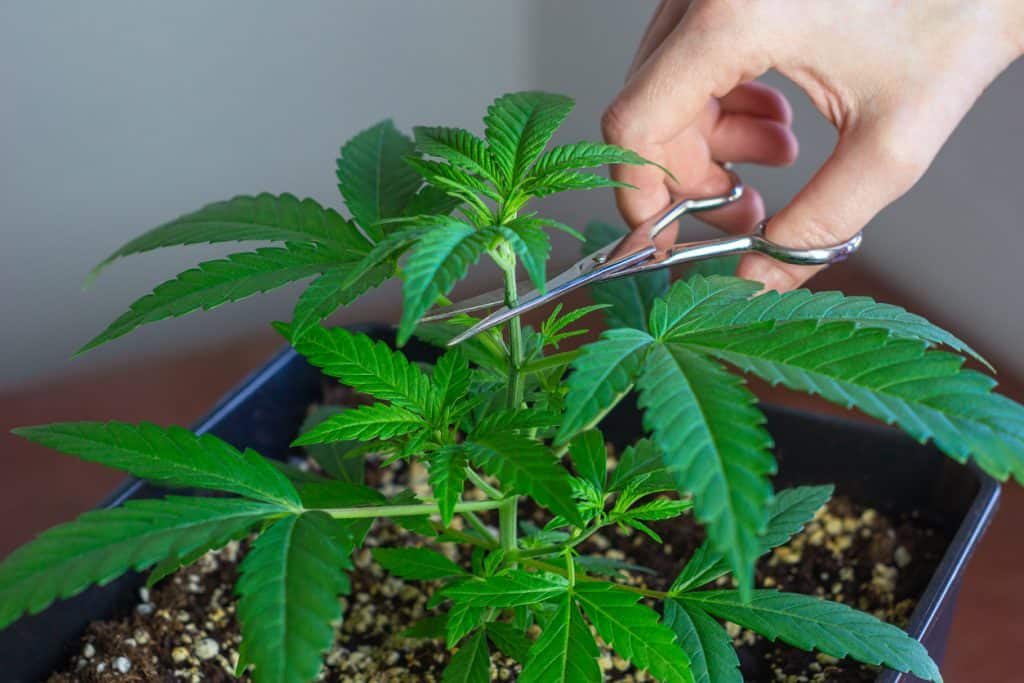
Better Light Penetration
Light is extremely important for your weed plant. The more light your weed plant gets, the more photosynthesis it can perform, which ultimately allows it to turn more energy into more fuel, for faster and more efficient growth. Cannabis pruning allows the biggest leaves to get more light, therefore increasing growth efficiency and growth rate. Whether indoor plants or outdoor plants, this is always important. The more light exposure your plants get, the better. It’s all about providing your cannabis plants with as much direct light as possible.
Better Airflow
You then also need to consider that when you prune cannabis, you provide the plant with better air flow. This is very important because better air flow allows for more temperature and humidity control, it reduces the instances of pests, and it also reduces the chances of mold and mildew from occurring. This is even the case with outdoor plants. Most people don’t think about air flow when they prune marijuana, But this is something that allows for much healthier leaves.
More Energy for the Top Buds
When it comes to maximizing the yield of your cannabis plants, remember that if you remove the cannabis fan leaves lower down on the plant, particularly during the flowering stage, you will allow the plant to focus more on the growth of the flowers and buds. Cannabis cultivation is all about knowing which parts of your plant need the most possible energy, and removing some leaves lower down on the plant will eventually allow for increased flower production.
Reducing Pests
By engaging in some regular pruning sessions using those handy pruning snips, you can also help reduce the instances of pests from taking hold. At the very least, you’ll be able to see pests as they infest your plants, therefore allowing you to take action as quickly as possible.
Increasing Nutrient Distribution
Related to one of the above points, cannabis defoliation or pruning is also important because it helps to evenly distribute nutrients throughout the plant. Instead of the plant providing the cannabis leaves with nutrients, it will start to focus more of those nutrients into the buds and flowers. There’s simply no point in the plant focusing its energy on dying leaves.
Controlling Vertical Growth
When you grow cannabis, especially if your plants don’t get the most sun exposure possible, it may result them in growing very tall and skinny. This is a problem because if the stem is too skinny, it won’t be able to support the buds and branches. Experienced growers all know that it’s better to grow wide plants that are thick and bushy than it is to grow tall and implants. Certain pruning techniques, such as topping, which involves cutting off the cola at the bud site, results in increased width as opposed to height.
Making Harvest Easier
At the very least, if you trim your cannabis plants regularly and engage in two or three pruning sessions throughout the growth cycle, it should help make the harvest process easier by removing excess foliage.
Overall Bigger Yields
What it really comes down to is that pruning marijuana plants during various growth stages allows for bigger yields in general. Pruning cannabis plants provides them with more light, allows them to focus more energy on the important aspects, increases air flow, and much more. At the end of the day, it allows the plant’s energy to be focused on the most important parts, those THC rich flowers.
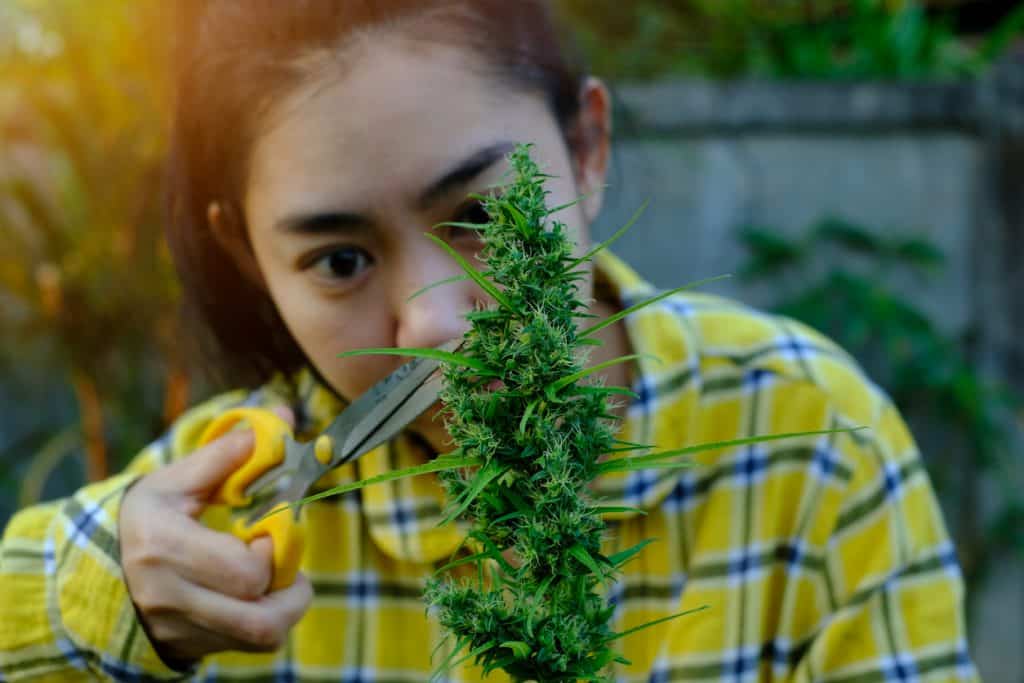
Marijuana Plants Trimming Techniques
If you are hoping to increase your final yield using nothing more than those trimming scissors, then you are on the right track.
Right now, we want to take a closer look at some of the different cannabis pruning techniques that help to get rid of unwanted growth, both during the veg stage and flowering phase, so you can increase bud production and stimulate growth in the most important parts. We recommend that you start pruning various cannabis strains at about the third week of growth.
Most growers recognize that the sooner they prune cannabis plants, the better the bud production ends up being. Let’s take a look at some of the most used pruning techniques.
Defoliation
One of the best techniques at your disposal to increase blood production and your overall yields is to cut away excess foliage. If you have dying leaves or leaves that are not exposed to much light, then there is not much point in keeping them.
Light exposure is very important, and if leaves don’t get exposed to light, they won’t be productive in terms of helping your plant grow, but they will keep using stored nutrients and energy to maintain their health. Defoliation is all about cutting away leaves that don’t contribute anything, or don’t contribute much, to the overall growth of the buds.
Topping
One of the best cannabis pruning techniques is known as topping, and this is something that will help to encourage increased bud production. Topping the plant, which means cutting off the top cola, as well as the colas on the branches, will effectively result in the doubling of the colas. When you cut one cola off, another two will grow back in its place.
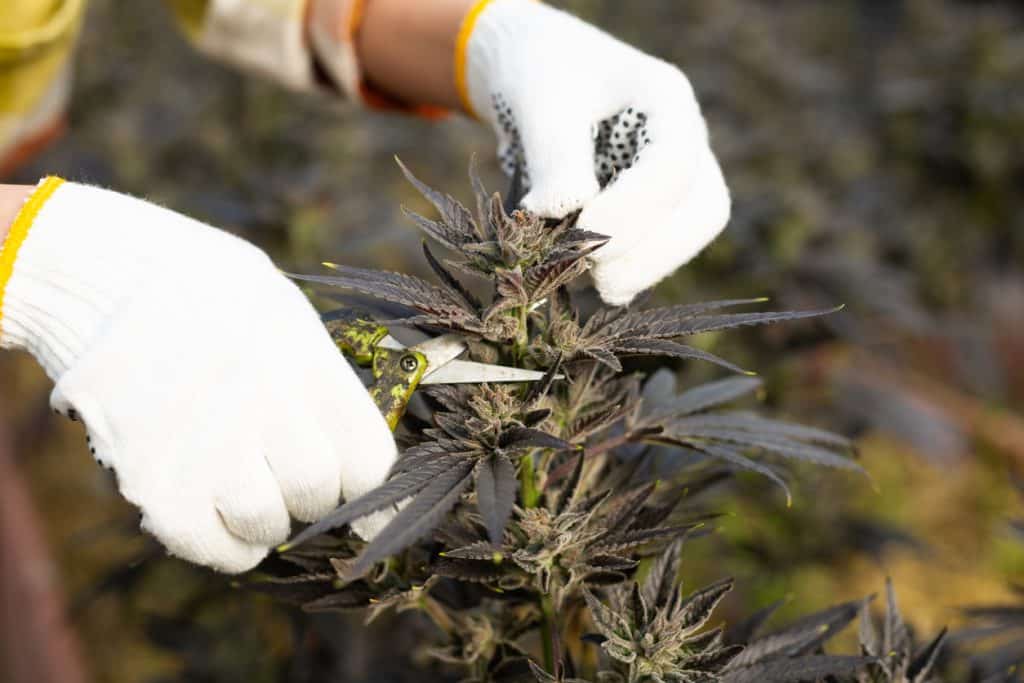
Main-Lining
Main lining a cannabis plant is a combination of stress training and pruning technique. This involves cutting off the colas, just like with topping, but then also tying the plant down to encourage horizontal growth. If done properly, you can multiply the number of buds that you’re planning produces by up to 8 or even 10 times. This is however a fairly dangerous method, because it does cause a lot of stress to plants. If you do this technique too much, or don’t do it properly, you may kill your cannabis plants.
Lolli-Popping
The lollipop technique involves cutting off the lower branches of the cannabis plant, about the lower third, which then causes more of the energy to be focused into the canopy of the cannabis plant, which is where most of the buds will grow anyway. It’s all about maximizing light exposure.
Removing Diseased Leaves
Although not exactly a pruning method per se, you should always look to remove all diseased leaves. If there are leaves that are diseased, they may spread their disease to the other leaves. At the very least, your plant will keep using its stored nutrients and energy to try and heal that leaf and to let it continue growing. However, the better solution is to simply cut it away so that the plant can then focus its energy into the healthy parts.
When to Trim Cannabis Plants
Important to note is that you can’t use all of the trimming techniques during all of the growth stages. Let’s take a look at the best trimming techniques to use during various growth stages.
Trimming Plants in the Vegetative Stage
If you plan on using the topping technique, beware that you can only do this during the vegetative stage. If you try to top your cannabis plant during the flowering stage, the top cola will not grow back anymore, nor will those on the branches. Do not top a cannabis plant during the flowering stage.
Another trimming technique that you can use to prune cannabis during the vegetative stage is regular pruning. Here, just focus on removing some of the lower leaves, particularly those that don’t get exposed to much light. You may also want to remove any leaves that are diseased. Furthermore, if you plan on mainlining your plant, the vegetative stage is when to do it.
Trimming Leaves During Flowering Stage
If you plan to prune a cannabis plant during the flowering stage, there are two main techniques that you can use. One is defoliation, which you should do within the first three weeks of the flowering stage. If you remove unwanted growth, such as dying leaves or leaves that are not being exposed to much light, you’ll allow the plant to focus more of its energy on growing buds.
When your cannabis plant reaches roughly the middle of the flowering stage, you can use the lollipop technique, which effectively removes the lower third of the branches that don’t get much light anyway. Then, during the final few weeks before harvest, try to get rid of any fan leaves that are blocking the buds from receiving light. The more light your buds get, the more resume will produce.
Trimming Marijuana Plants for Maximum Yield: FAQ
Before we call it a day, let’s quickly answer some of your most frequently asked questions about pruning cannabis.
Do Weed Plants Benefit from Pruning?
Yes, thanks to increased air flow, better light exposure, and the focusing of energy on higher yields, cannabis plants benefit from pruning.
Will My Cannabis Plant Die If I Cut Away a Fan Leaf?
If you just cut away a fan leaf or a couple of fan leaves, it won’t do any damage to your plant. Just remember that the fan leaf is designed to capture sunlight, and therefore to perform photosynthesis. If you cut away all of the fan leaves, your plant won’t be able to grow anymore.
What Sort of Pruning Can I Do During the Vegetative Growth Stage?
During the vegetative growth stage, the best type of pruning to do is the topping of cannabis plants.
Do Buds Grow on Marijana Fan Leaves?
No, buds do not grow on fan leaves.
Is Topping Cannabis Plants Safe?
There is always a certain risk involved when topping cannabis plants. However, the risk is minimized when topping cannabis plants is done during the vegetative growth stage.
When Do I Trim Away Sugar Leaves?
Sugar leaves do not need to be trimmed away during the growth stage. You can trim the sugar leaves away when you have harvested your plant.

